How to Grow & Care for (Loofah) Luffa sponge
Written by Iris
Oct 22 2021
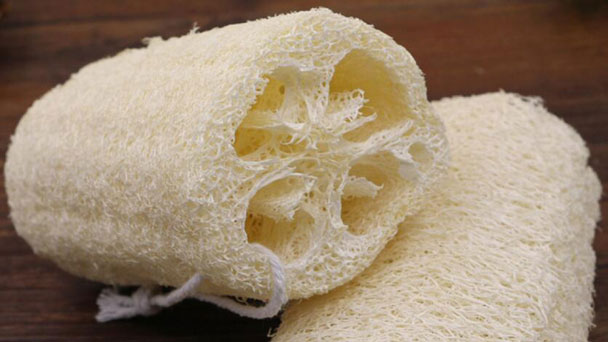
Loofah (Luffa sponge) is not a typical garden vegetable, growing slowly and ripening until fall. Loofah likes plenty of sun, hot summer temperatures, plenty of water and well-drained soil. Under the right conditions, Loofah (Luffa sponge) grows vigorously, sometimes as long as 30 feet. When the elevated lattice is provided, the tendrils of the grapevine wind and wind and pass through the elevated support. They can even create a natural awning.
The plants are robust climbers and happily scramble up or across a strong support like a chain link fence, trellis, arbor, garden arch, tunnel, or other structure. It makes a great summer screening plant if you’re looking for more privacy in your yard or adds shade to a pergola over a seating area. You can also let the plants roam freely over the ground, but be warned they cover a lot of space. They fruits also grow straighter if trellised.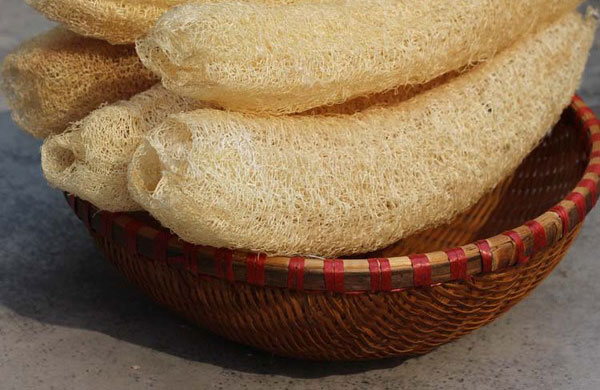
Soaking the seed for a few hours in lukewarm water ahead of sowing can help to encourage better germination. Fill your pots up loosely with compost and tap down lightly once or twice.
Hold the loofah seed, sides on, between finger and thumb and push it sideways down into the loose compost, about 1.5cm deep.
Tap the pot again to settle the soil over the hole. Make sure you pop a label in to avoid mix-ups later.
Then the pots need heat, lots of lovely heat! 25 degrees Celsius of heat. So, putting your pots into a heated propagator box is best for success.
Once you've sown your seeds and placed them into the propagator be sure to water them water them. Avoid overwatering though, as this can cause the seeds to rot.
Try to resist the temptation to keep taking the lid off for a peep, as this will let the built-up moisture out of the propagator.
Germination won't take long at 25 degrees, so check in a week but they may take 2 or even 3 weeks at cooler temperature. Too cool a temperature and the seed may rot rather than germinate, so the warmth is very important.
Once the roots are starting to show through the holes at the base of the pot it's time to pot them up. We pot ours into bucket-size pots but if your indoor space is limited you could use smaller ones and increase the size as the plant grows.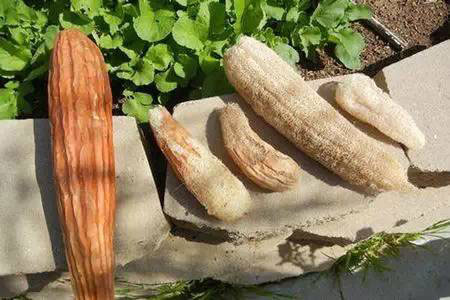
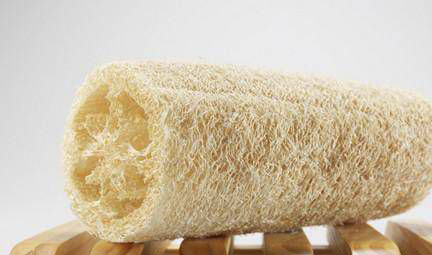
Nitrogen is essential at the seedling stage but, before your luffas start blooming, they will need phosphorus for root growth. Before settings of the fruit, your plants will need a higher potassium formulation. The best choice is fertilizer with an NPK ratio of 1-2-2 (for example, 5-10-10).
To provide a constant supply of nutrients for this vegetable, you may even consider applying aged manure, finished compost, or commercial fertilizer once a month.
Cucumber beetles, squash vine borers, and squash bugs are the main insect pests. Regularly check your plants for signs of an invasion. You can also check the underside of leaves and remove eggs before they hatch.
Squash vine borers can be especially detrimental to your plants because they bore inside the vines and will eventually kill them. You can prevent this in young plants by wrapping strips of row cover around the base and up the vines as they grow.
If you notice little piles of shavings at the base of your plants or along the vines, you probably have a borer already inside. You can cut it out with a sharp knife by slicing open one side of the vine. After you remove the culprit, bury the sliced section under soil if possible.
The most common disease problems are fungal pathogens like powdery mildew. These usually aren’t bad enough to kill your plants, but the best prevention is to space plants properly and avoid getting the leaves wet as much as possible.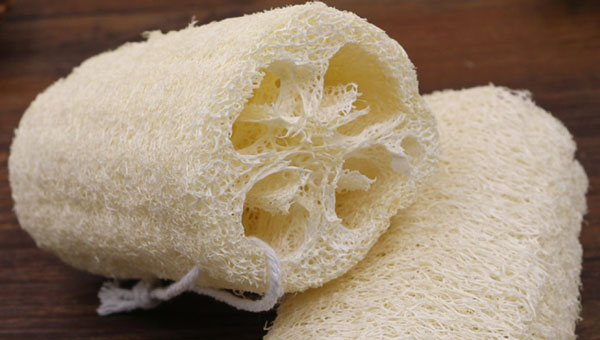
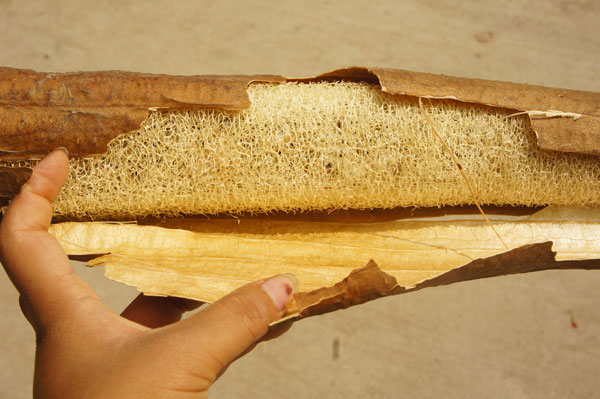
Where to Grow LoofahHow to Grow Loofah (Luffa sponge)Loofah Propagation with SeedsHow to Care for Loofah (Luffa sponge)Loofah Light RequirementsLoofah Soil CareLoofah WateringLoofah Temperature & HumidityLoofah FertilizerLoofah Pests & DiseasesVarieties of Loofah (Luffa sponge)Loofah Care FAQHow long does loofah take to grow?What is a loofah used for?
Where to Grow Loofah
Loofah gourds are produced on vigorous plants that can grow up to thirty feet long. It's important to provide, a sunny spot and encourage fast, consistent growth by maintaining soil moisture and feeding the plants regularly.Give your plants a good start at planting time by digging in several inches of compost or aged manure.The plants are robust climbers and happily scramble up or across a strong support like a chain link fence, trellis, arbor, garden arch, tunnel, or other structure. It makes a great summer screening plant if you’re looking for more privacy in your yard or adds shade to a pergola over a seating area. You can also let the plants roam freely over the ground, but be warned they cover a lot of space. They fruits also grow straighter if trellised.

How to Grow Loofah (Luffa sponge)
Loofah Propagation with Seeds
Loofah seeds don't germinate quite as easily as cucumbers or courgettes, so sow a few extra to be sure to have enough plants.Soaking the seed for a few hours in lukewarm water ahead of sowing can help to encourage better germination. Fill your pots up loosely with compost and tap down lightly once or twice.
Hold the loofah seed, sides on, between finger and thumb and push it sideways down into the loose compost, about 1.5cm deep.
Tap the pot again to settle the soil over the hole. Make sure you pop a label in to avoid mix-ups later.
Then the pots need heat, lots of lovely heat! 25 degrees Celsius of heat. So, putting your pots into a heated propagator box is best for success.
Once you've sown your seeds and placed them into the propagator be sure to water them water them. Avoid overwatering though, as this can cause the seeds to rot.
Try to resist the temptation to keep taking the lid off for a peep, as this will let the built-up moisture out of the propagator.
Germination won't take long at 25 degrees, so check in a week but they may take 2 or even 3 weeks at cooler temperature. Too cool a temperature and the seed may rot rather than germinate, so the warmth is very important.
Once the roots are starting to show through the holes at the base of the pot it's time to pot them up. We pot ours into bucket-size pots but if your indoor space is limited you could use smaller ones and increase the size as the plant grows.

How to Care for Loofah (Luffa sponge)
Loofah Light Requirements
Luffa needs at least six or more hours of full sun—the more the better.Loofah Soil Care
To grow healthy and vigorous, your luffa gourds will require the well-drained, loam or sandy ground, with a pH of 5.5 – 6.8. It is always a good idea to do a soil test before planting your veggies.Loofah Watering
Loofah sponges need moisture to sprout, and their seedlings need time and adequate watering for proper roots’ development. Never let the ground get too dry. If the pot is small, you need to water the soil every day, but you should take care not to over water. Keep watering your plants once you transplant them in the garden. On average, they will need 1 inch (2.5 cm) of water a week. Consider installing the drip-irrigation system for your luffas.Loofah Temperature & Humidity
Luffa needs warm to hot weather, in cool weather, its growth will slow down.
Loofah Fertilizer
Your plants will need at least two or three serious fertilizing during the growing season. You will need to add approximately 20 to 25 pounds (9 – 11 kg) of nitrogen per acre (0.4 ha) and an adequate amount of potash and phosphate.Nitrogen is essential at the seedling stage but, before your luffas start blooming, they will need phosphorus for root growth. Before settings of the fruit, your plants will need a higher potassium formulation. The best choice is fertilizer with an NPK ratio of 1-2-2 (for example, 5-10-10).
To provide a constant supply of nutrients for this vegetable, you may even consider applying aged manure, finished compost, or commercial fertilizer once a month.
Loofah Pests & Diseases
Loofah (Luffa sponge) plants can be attacked by the same insects and diseases that other winter squash and gourds are beset by.Cucumber beetles, squash vine borers, and squash bugs are the main insect pests. Regularly check your plants for signs of an invasion. You can also check the underside of leaves and remove eggs before they hatch.
Squash vine borers can be especially detrimental to your plants because they bore inside the vines and will eventually kill them. You can prevent this in young plants by wrapping strips of row cover around the base and up the vines as they grow.
If you notice little piles of shavings at the base of your plants or along the vines, you probably have a borer already inside. You can cut it out with a sharp knife by slicing open one side of the vine. After you remove the culprit, bury the sliced section under soil if possible.
The most common disease problems are fungal pathogens like powdery mildew. These usually aren’t bad enough to kill your plants, but the best prevention is to space plants properly and avoid getting the leaves wet as much as possible.

Varieties of Loofah (Luffa sponge)
There are two species of luffa – Luffa acutangula, best for flavour, which looks like a fluted green barrage balloon about 28cm/10in long and L..cylindrica, which looks very similar to a courgette, except that the skin is smooth, shinier and fairly hard rather than slightly bristly. Both have similar leaves, deeply lobed and sprawl rather than climb, using tendrils. Individual plants have flowers of a single sex. Inside both species of luffa is a creamy flesh with many small seeds, similar to a courgette in texture and flavour. The two species will hybridise if grown even at considerable distances apart, so if you want to save seeds it's better to only grow one species at a time. The smooth luffa tends to produce fruits in shortening days (after midsummer in the UK) while angled luffa is unaffected by day-length. At present there are no specific cultivars sold in the UK, but a range of varieties exists elsewhere, including plants with long, short or rounded fruits, and differences in length of time from seed to fruit production. Some cultivars are selected for the quality of their hard internal fibres, used for sponges, while others are grown for medicinal properties, particularly in China. ‘Satiputiya’ is a hermaphrodite variety.
Loofah Care FAQ
How long does loofah take to grow?
Timing is especially important if you're growing loofah for the sponge. The fruits will take 150-200 days to reach maturity (hint: that's more than 4 months). To make things even more difficult, loofahs have to be harvested before the frost hits, or they'll rot & be unusable.What is a loofah used for?
Loofahs — sometimes spelled luffas — are popular shower accessories used for cleaning and exfoliating your skin. Some people think that “all-natural” loofahs are made of sea sponge or dried coral because of their coarse, spongy consistency. But natural loofahs are actually made from a gourd in the cucumber family.Latest Updated
- Benefits of Bugleweed - 7 Science-backed Health Benefits
- Bugleweed Dangers & Side Effects - Is It Poisonous?
- How to Plant Evergreen Trees - What You Should Know
- When to Plant Evergreens - Grow Guide for Evergreen Trees
- 12 Wonderful Evergreen Shrubs for Your Garden
- 12 Popular Evergreen Plants with Pictures for Beginners
- When And How To Prune A Lilac Bush Like a Pro
- How to Grow & Care for Lilac Vine (Hardenbergia Violacea)
- Japanese Lilac Tree (Syringa Reticulata) Care & Propagation Guide
- Shumard Oak Pros and Cons - What to Know
Popular Articles
- Winter maintenance of Antirrhinum Majus
- How to Grow Terminalia Mantaly Tree
- How to Grow and Care for Crossostephium Chinense
- How to grow Antirrhinum Majus in spring
- Peristeria Elata (Dove Orchid) Profile: Info & Care Guide
- Underwatered Snake Plant (Sansevieria Trifasciata) - Signs And How To Fix
- How to Care for Brazilian Jasmine Plant (Mandevilla Sanderi)
- How to Grow & Care for Graptopetalum Purple Delight in Summer
- Rosa Chinensis (China Rose): Plant Growing & Care Tips
- How to Care for Baby Sun Rose (Aptenia Cordifolia)